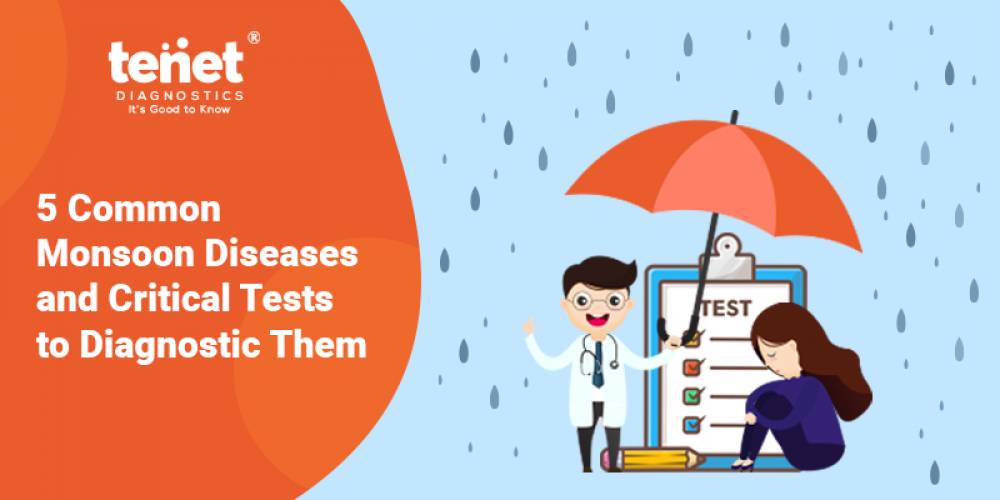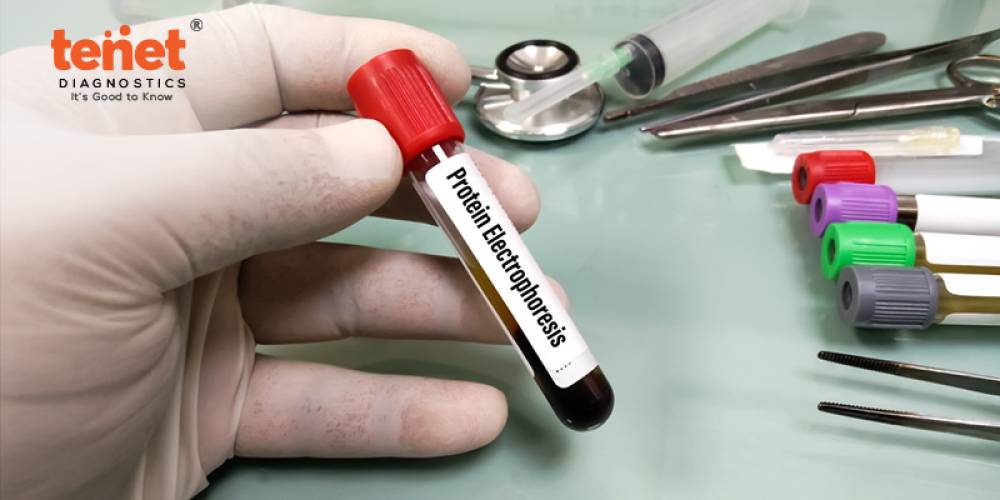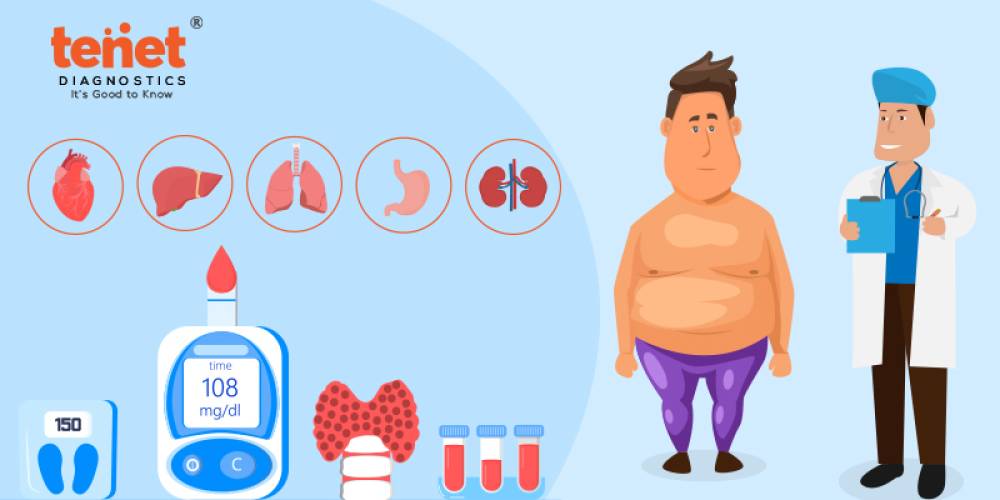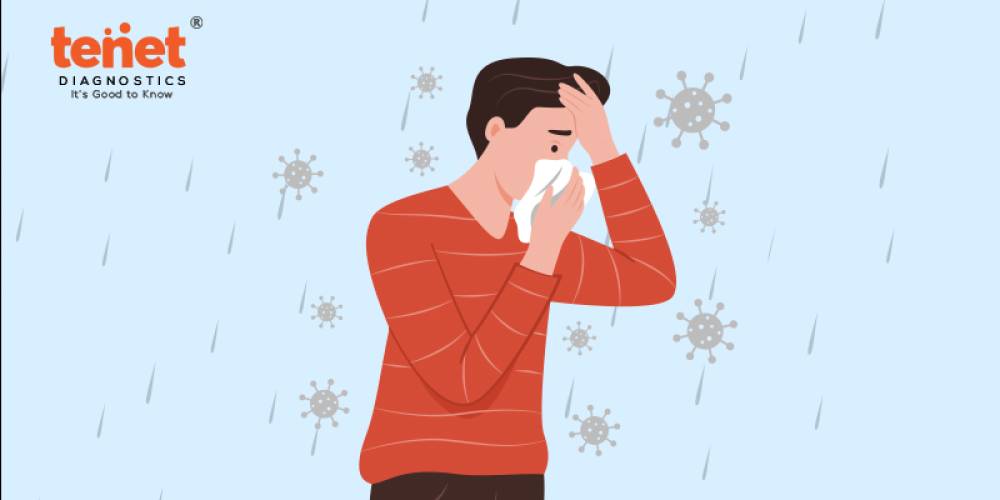While the monsoon season provides relief from the oppressive summer heat, it also presents a number of health risks. Diseases can spread more easily in an environment with higher humidity and stagnant water. To ensure early detection and effective treatment, it is crucial to comprehend typical monsoon diseases, their symptoms, and crucial monsoon diagnostic tests. In this post, we'll look at several common monsoon illnesses, how they're diagnosed, and how to avoid them to keep healthy at this time of year.
If you are looking to undergo monsoon diagnostic tests, visit Tenet diagnostics, the best diagnostic center in Hyderabad providing accurate results within no time.
Common Monsoon Diseases
The monsoon provides a risk to public health because of illnesses spread by mosquitoes and waterborne pathogens. Hence, regular health check-ups during monsoon are quite important. To protect our health during this exciting but sometimes dangerous season, it is essential to understand these diseases.
1. Malaria
The Plasmodium parasite is the deadly mosquito-borne illness that causes malaria. The monsoon season's stagnant rainwater creates the perfect breeding habitat for mosquitoes, particularly the disease-carrying Anopheles mosquito. The malaria parasite enters a person's circulation when an infected mosquito bites them. High fever, chills, headache, muscle aches, and exhaustion are a few of the signs of malaria. Malaria can cause serious complications and even death if it is not treated.
2. Dengue
The Aedes mosquito is principally responsible for transmitting this virus, which is also carried by mosquitoes. These mosquitoes can easily spawn in water-filled containers and puddles during the rainy season. High fever, excruciating headaches, aching joints and muscles, rashes, and bleeding tendencies are just a few of the signs of dengue. In severe cases, dengue can result in potentially fatal dengue hemorrhagic fever or dengue shock syndrome. Dengue cannot be treated specifically; thus, prevention is essential.
3. Chikungunya
Like dengue, chikungunya is a viral disease spread by the Aedes mosquito. High fever, excruciating joint pain, headache, muscular soreness, and skin rashes are a few of the signs of chikungunya. The joint pain may linger for weeks or months and can be crippling. Since there is no known treatment for chikungunya, the major goal of care is to reduce symptoms.
4. Typhoid
Salmonella typhi, the bacterium that causes typhoid, is mostly responsible for its transmission through tainted food and water. Due to flooding and poor sanitation, there is a higher danger of water contamination during the monsoon. Typhoid is characterized by a high temperature, headache, stomach pain, and appetite loss. Antibiotics can be used to treat typhoid, but a correct diagnosis is crucial.
5. Infections of the digestive tract
During the monsoon, tainted water and food can cause digestive tract infections like gastroenteritis. Viruses and bacteria that cause disease can produce symptoms like nausea, vomiting, stomach cramps, and diarrhea. To prevent gastrointestinal illnesses, proper hand washing, and the consumption of clean, safe food and water are crucial.
Tests To Diagnose Monsoon Diseases
To determine the underlying causes of monsoon diseases and to determine the best course of therapy, various tests must be performed. Here are the vital exams frequently included in a monsoon test package to identify ailments linked to the monsoon season:
1. Complete Blood Count (CBC)
A CBC test is a common blood examination that counts the red blood cells, white blood cells, and platelets among other blood constituents. It aids in the identification of infections, anemia, and other anomalies that can point to a monsoon-related illness. This test is often present in most monsoon health packages.
2. Test for Blood Culture
A blood culture is a diagnostic procedure used to find out whether there are any bacteria or fungi in the blood. It is essential for identifying severe infections that can develop as complications of several monsoon illnesses, like septicemia.
3. Urine Analysis
A urine analysis checks the presence of any aberrant materials, cells, or microbes in the urine. It is useful for identifying UTI and other monsoon-related illnesses that are spread by polluted water.
4. Serological Tests
Serological tests look for particular antibodies in the blood that could be signs of a recent or ongoing infection. These exams are frequently used to identify viral illnesses and diseases spread by mosquitoes, such as dengue and chikungunya. This is a crucial test in monsoon health screening packages.
Final Words
There are many prevalent diseases that we need to be aware of and take precautions against when the monsoon season approaches. During this time of year, there is a higher chance of developing a variety of illnesses, from mosquito- and water-borne infections like malaria and dengue to gastrointestinal disorders and typhoid.
We have examined common monsoon diseases in-depth in this post, learning about their symptoms, underlying causes, and the value of early detection. It is impossible to exaggerate the importance of crucial diagnostic tests for monsoon such the complete blood count (CBC), blood culture, serological assays, and PCR tests. These tests are essential for early diagnosis and effective monsoon-related disease treatment.







